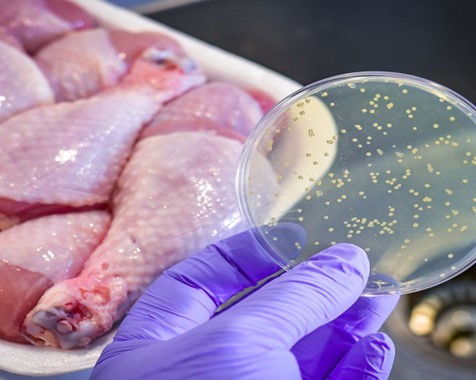PCR-based Assay Method for Quantification of Salmonella or Other Microbes in Food Samples
- Patent Pending
Introduction: Salmonella enterica is a leading cause of bacterial foodborne illnesses worldwide. Salmonella strains cause about 93 million enteric infections annually, which results in 155,000 global deaths. In the U.S., strains of Salmonella are responsible for around 1.35 million cases each year. Despite strong measures by the regulatory agencies (i.e., USDA, FDA) and implementation of various process controls, the Salmonella incidence rate of infection has increased from 15 cases per 100,000 in 2010 to 18.3 cases per 100,000 in 2018.
Knowing a target organism’s concertation range, such as Salmonella, is critical for many industries including the food and diagnostic industry. A food sample with a low level of pathogens may not present a hazard while a higher level of pathogen does. Knowing when the pathogen level approaches the threshold level for safety is important. Current methods of estimating the concertation of microorganisms are based on the most probable number method (MPN). The MPM method is slow, culture-based, laborious, and requires two or more days for completion. Beef or poultry processors who wish to assess a threshold level of Salmonella concentrations of meat currently have to rely on the MPN based method. Some current molecular methods on the market can provide concentration determination, but they rely on external standard curve and regression are required to measure organism concentration. As each sample varies in composition, microbial load and presence of natural inhibitor (i.e., sample matrix effects for each sample type), a separate standard curve is needed.
Working Principle: Our approach takes advantage of varying PCR amplification efficiencies achieved by the introduction of mismatches in the Salmonella-specific primer sequence. The selected set of primers are used for estimating the initial Salmonella load in the test samples. The primer sequence exactly matching the target gene is amplified at the highest amplification efficiency and can detect the lowest concentration of Salmonella. Whereas primers designed with an increasing number of mismatches result in sequentially lower amplification efficiencies, which in turn enables detection of different log10-fold Salmonella concentrations (10-104 CFU). As PCR amplification is carried out using primers with mismatches, assay specificity is achieved through a Salmonella-specific dual-labeled probe. Using this approach, a selected set of primer pairs can be used to detect and estimate initial Salmonella concentration in food directly or after enrichment based on the growth dynamics of the pathogen.


